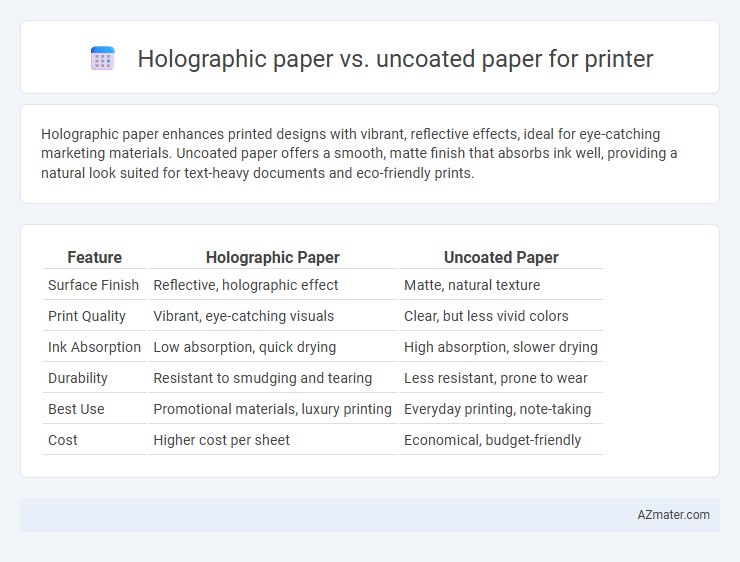Holographic paper enhances printed designs with vibrant, reflective effects, ideal for eye-catching marketing materials. Uncoated paper offers a smooth, matte finish that absorbs ink well, providing a natural look suited for text-heavy documents and eco-friendly prints.
Table of Comparison
| Feature | Holographic Paper | Uncoated Paper |
|---|---|---|
| Surface Finish | Reflective, holographic effect | Matte, natural texture |
| Print Quality | Vibrant, eye-catching visuals | Clear, but less vivid colors |
| Ink Absorption | Low absorption, quick drying | High absorption, slower drying |
| Durability | Resistant to smudging and tearing | Less resistant, prone to wear |
| Best Use | Promotional materials, luxury printing | Everyday printing, note-taking |
| Cost | Higher cost per sheet | Economical, budget-friendly |
Introduction to Printing Paper Types
Holographic paper features a reflective, visually striking surface ideal for eye-catching labels and specialty prints, whereas uncoated paper offers a natural, matte finish suitable for everyday printing and text-heavy documents. Holographic paper enhances color vibrancy and adds a dimensional effect, but it requires compatible printers to avoid smudging and ensure high-quality output. Uncoated paper provides better ink absorption and is more versatile for general-purpose printing tasks, making it a practical choice for professional reports and flyers.
What is Holographic Paper?
Holographic paper is a specialized printing substrate embedded with a reflective, multi-dimensional surface that creates dynamic, colorful light effects, enhancing visual appeal and security features. It is commonly used for packaging, labels, and certificates due to its eye-catching appearance and resistance to counterfeiting. Unlike uncoated paper, which has a matte, porous surface suitable for writing and standard printing, holographic paper requires compatible printers and inks to maintain its unique optical properties.
Understanding Uncoated Paper
Uncoated paper features a porous surface that absorbs ink quickly, resulting in less vibrant colors but superior writing and handling qualities compared to holographic paper. Unlike holographic paper, which emphasizes visual impact with its reflective and metallic finish, uncoated paper offers a natural, matte texture ideal for text-heavy documents, reports, and everyday printing. Its compatibility with various ink types and reduced risk of smudging make uncoated paper a practical choice for printers requiring clarity and durability over glossy aesthetics.
Visual Appeal: Holographic vs Uncoated Paper
Holographic paper offers a vibrant, iridescent finish that enhances visual appeal through dynamic light reflections and color shifts, making printed materials stand out with a modern, eye-catching effect. Uncoated paper provides a matte, natural texture that delivers a classic, understated appearance but lacks the reflective qualities and brightness seen in holographic options. For projects emphasizing visual impact and attention-grabbing aesthetics, holographic paper is the superior choice, whereas uncoated paper suits designs requiring a subtle, elegant look.
Print Quality Comparison
Holographic paper offers superior print quality for printers by enhancing color vibrancy and providing reflective, eye-catching effects that uncoated paper cannot achieve. Unlike uncoated paper, which absorbs ink leading to duller prints and lower sharpness, holographic paper maintains crisp details and high contrast due to its smooth, metallic surface. This results in printed materials with a striking visual appeal, ideal for invitations, packaging, and marketing collateral demanding premium aesthetics.
Durability and Handling Differences
Holographic paper offers superior durability compared to uncoated paper, as its glossy, reflective surface resists water, smudges, and tearing, making it ideal for premium prints and labels. Uncoated paper is more porous and absorbs ink quickly but is prone to smudging and damage from moisture, requiring careful handling during and after printing. Handling holographic paper demands precise printer settings to avoid jams or surface scratches, while uncoated paper is generally easier to feed and less sensitive to printer calibration.
Cost Analysis Between Holographic and Uncoated Paper
Holographic paper typically incurs higher costs due to its specialized manufacturing process and premium materials, often priced at 3 to 5 times more than standard uncoated paper. Uncoated paper remains the economical choice for bulk printing projects, with prices averaging between $0.01 to $0.05 per sheet, while holographic paper can range from $0.10 to $0.25 or more per sheet depending on quality and finish. For businesses prioritizing budget efficiency, uncoated paper delivers significant savings, whereas holographic paper offers added value through visual appeal at a substantially increased cost.
Best Use Cases for Holographic Paper
Holographic paper excels in printing high-impact marketing materials, product packaging, and special event invitations where visual appeal and uniqueness are paramount. Its reflective, multi-dimensional surface enhances brand recognition and creates eye-catching designs that stand out on retail shelves or promotional displays. Compared to uncoated paper, holographic paper is best suited for projects requiring vibrant, dynamic effects and durability against wear, while uncoated paper is preferable for standard printing needs like business documents or casual flyers.
Ideal Applications for Uncoated Paper
Uncoated paper is ideal for printing materials that require easy writing, high opacity, and a matte finish, such as letterheads, envelopes, and business forms. Its porous surface enhances ink absorption, resulting in crisp text and vibrant colors that are perfect for reports, flyers, and brochures where readability is paramount. Compared to holographic paper, uncoated paper offers superior versatility for everyday printing tasks that prioritize functionality over decorative effects.
Choosing the Right Paper for Your Printing Needs
Holographic paper offers vibrant, eye-catching designs with reflective, iridescent effects ideal for promotional materials, labels, and creative projects, enhancing visual appeal but often at a higher cost with specific printer compatibility requirements. Uncoated paper provides a natural, matte finish suited for everyday printing needs, such as flyers, business documents, and manual prints, delivering affordability and smooth writing surfaces without glare or shine. Selecting the right paper depends on the desired aesthetic, printer type, budget constraints, and the functional purpose of the printed material to ensure optimal print quality and user experience.

Infographic: Holographic paper vs Uncoated paper for Printer
 azmater.com
azmater.com